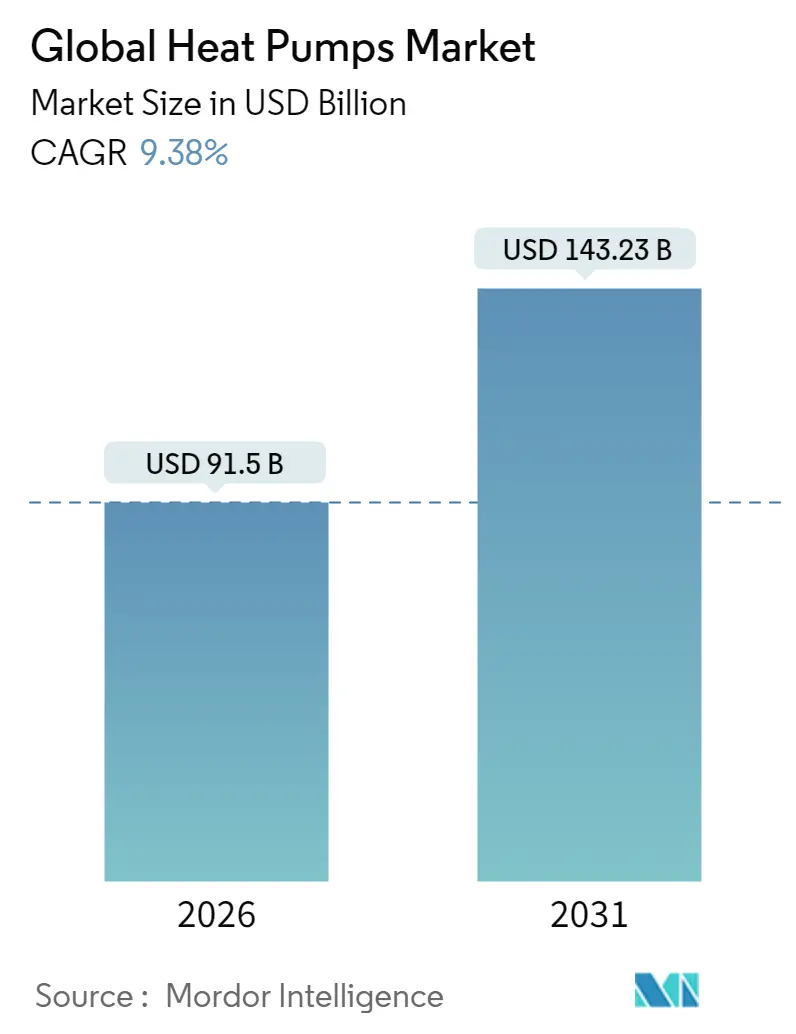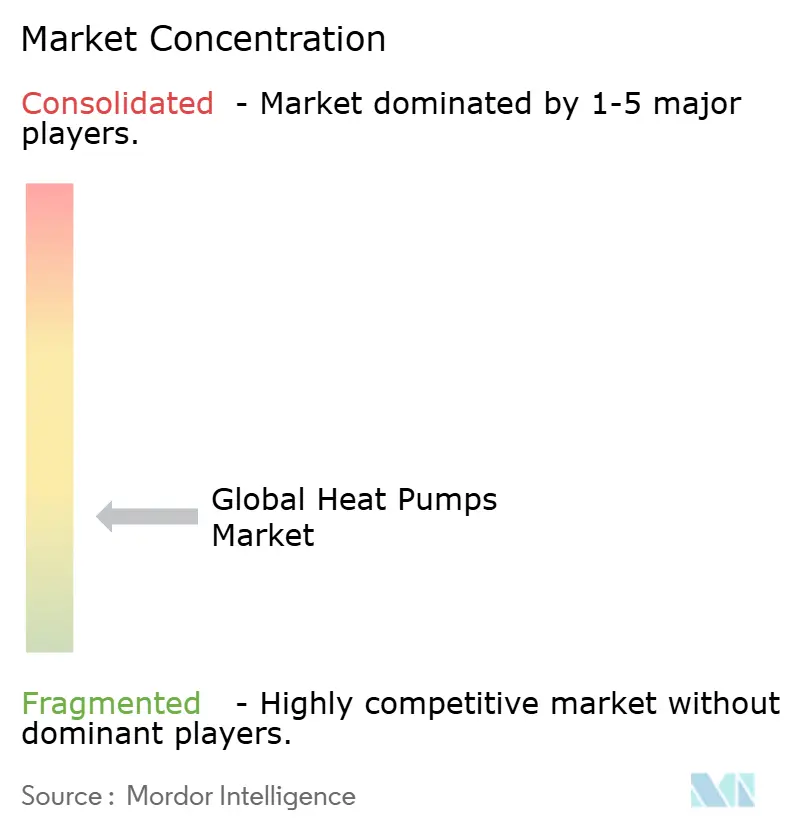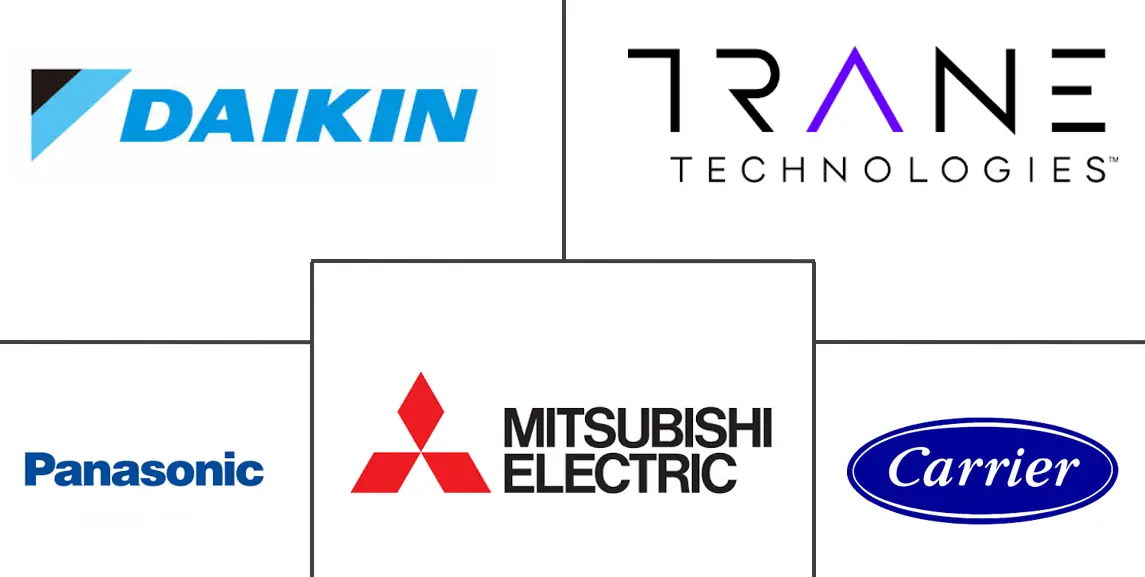
Global Heat Pumps Market Analysis by Mordor Intelligence
The heat pump market was valued at USD 83.66 billion in 2025 and estimated to grow from USD 91.5 billion in 2026 to reach USD 143.23 billion by 2031, at a CAGR of 9.38% during the forecast period (2026-2031). Decarbonization mandates in Europe and North America, large federal and provincial incentive packages, and ever-larger utility-scale projects positioned the heat pump market as the leading replacement pathway for fossil-fuel-based space and water heating solutions. [1]Clean Energy Wire, “Q&A – Germany agrees phaseout of fossil fuel heating systems,” cleanenergywire.org China’s integrated manufacturing base held costs down while inverter-driven compressor advances narrowed performance gaps in sub-zero environments, setting the stage for rapid uptake in colder regions. Supply-chain localization efforts in the United States and Poland mitigated tariff and freight risks while growing “Heat-as-a-Service” finance models addressed steep upfront installation costs that had slowed adoption in existing buildings.
Key Report Takeaways
- By source type, air-source systems led with 73.12% of the heat pump market share in 2025; ground/geothermal units are projected to expand at a 12.35% CAGR through 2031.
- By rated capacity, systems up to 10 kW accounted for 45.92% share of the heat pump market in 2025, while units above 30 kW record the highest projected CAGR of 12.18% to 2031.
- By system design, split systems held 60.95% revenue share in 2025; hybrid configurations are set to grow at a 13.62% CAGR by 2031.
- By end-user, residential installations captured a 56.98% share in 2025, whereas industrial demand is advancing fastest at an 11.29% CAGR.
- By application, space heating and cooling represented 66.02% of 2025 sales; district heating networks are forecast to register a 13.26% CAGR through 2031.
- By geography, Asia-Pacific commanded a 38.05% share of the heat pump market in 2025, while Europe is expected to be the fastest-expanding region at an 10.92% CAGR.
Note: Market size and forecast figures in this report are generated using Mordor Intelligence’s proprietary estimation framework, updated with the latest available data and insights as of January 2026.
Global Heat Pumps Market Trends and Insights
Drivers Impact Analysis
| Driver | (~) % Impact on CAGR Forecast | Geographic Relevance | Impact Timeline |
|---|---|---|---|
| Government decarbonization incentives and mandates | +2.1% | Global; strongest in Europe and North America | Medium term (2-4 years) |
| Electrification-driven HVAC replacement cycles | +1.8% | Global; accelerated in developed markets | Long term (≥ 4 years) |
| Rapid cost declines in inverter-driven compressors | +1.4% | Global; manufacturing centered in Asia-Pacific | Short term (≤ 2 years) |
| Grid-interactive heat pumps enabling demand-response revenue | +1.0% | North America and Europe | Medium term (2-4 years) |
| Cold-climate heat pump technology breakthroughs | +1.2% | Northern North America, Northern Europe, Northeast Asia | Medium term (2-4 years) |
| Heat-as-a-Service business models unlocking financing | +0.8% | Europe and North America | Long term (≥ 4 years) |
| Source: Mordor Intelligence | |||
Government decarbonization incentives and mandates
Aggressive policy frameworks created binding demand for heat pumps by tying building codes and subsidy levels directly to renewable heat outcomes. The US Inflation Reduction Act offered combined federal tax credits and state rebates as high as USD 14,000 per household, while Germany enforced its 65% renewable-heat requirement for all new heating systems starting in 2024. Canada’s Oil to Heat Pump Affordability Program provided up to CAD 15,000 (USD 11,100) to lower-income homes, and the UK’s Boiler Upgrade Scheme paid grants of up to GBP 7,500 (USD 9,400). These measures set artificial demand floors that shielded manufacturers from macroeconomic slowdowns and accelerated market penetration.
Electrification-driven HVAC replacement cycles
Local greenhouse gas caps in large cities condensed typical 15-20 year HVAC replacement intervals into fast-tracked retrofits that replace failing boilers with high-efficiency heat pumps. New York City’s Local Law 97 triggered projects such as the retrofit of 345 Hudson Street, combining heat pumps and waste-heat recovery to hit a 70% emissions-cut target by 2030. Massachusetts Utilities launched the first US geothermal network in Framingham, connecting 135 customers in 2024 and demonstrating district-level electrification potential.
Rapid cost declines in inverter-driven compressors
Component scaling and localized factories continued to push down compressor costs even as raw material prices fluctuated. Mitsubishi Electric announced a US-based compressor plant in 2024, while Sweden’s Aira opened a USD 321 million facility in Poland to reduce European reliance on imported parts. Firms employing next-generation swing-rotary designs achieved material savings of 15–20% without sacrificing output, translating to lower retail pricing.
Cold-climate heat pump technology breakthroughs
Laboratory and field results erased long-standing performance ceilings in sub-zero conditions. AAON’s Alpha Class maintained full heating capacity at 5°F and continued operating at −20°F, and Carrier’s units that passed the US DOE Cold Climate Challenge entered production in Tennessee in late 2024. [2]U.S. Department of Energy via ACHR News, “Carrier Passes Cold-Climate Heat Pump Challenge,” achrnews.com Academic research at Purdue University demonstrated thermoelectric-assisted systems with COPs above 2 at −15°C, broadening the viable addressable market into northern Scandinavia and Canada.
Restraints Impact Analysis
| Restraint | (~) % Impact on CAGR Forecast | Geographic Relevance | Impact Timeline |
|---|---|---|---|
| High installation and retrofitting costs in existing buildings | -1.6% | Global; most acute in developed markets | Medium term (2-4 years) |
| Skilled installer shortage | -1.1% | Global; severe in Europe and North America | Long term (≥ 4 years) |
| Electrical-panel and grid-capacity constraints | -0.9% | North America and Europe | Long term (≥ 4 years) |
| Competitive risk from hybrid hydrogen boilers | -0.4% | Europe, notably Germany and Netherlands | Medium term (2-4 years) |
| Source: Mordor Intelligence | |||
High installation and retrofitting costs in existing buildings
Total installed pricing diverged sharply by geography. Typical German row-house retrofits exceeded EUR 30,000 (USD 32,400), double France’s post-subsidy cost because of higher labor expenses and stricter permitting rules. A New York multifamily case study showed that electrical panel upgrades alone amounted to 40% of the project cost, highlighting infrastructure hurdles that incentives cannot fully offset.
Skilled installer shortage
Deployment capacity lagged behind equipment supply. The UK had an estimated 3,000 certified installers in 2024 but will need about 27,000 by 2028, inflating labor rates by 25–30% versus traditional HVAC work. Start-ups such as Heat Geek raised GBP 4 million (USD 5.1 million) in 2024 to provide rapid “business-in-a-box” training and customer-acquisition tools, yet the talent gap remained a binding constraint.
Segment Analysis
By Source Type: Air-Source Dominance Faces Geothermal Challenge
Air-source units held 73.12% heat pump market share in 2025 because of lower installation costs and product familiarity. However, the ground/geothermal category is forecast to post a 12.35% CAGR, the fastest within the spectrum, as utilities pilot networked loops such as the USD 14 million Framingham project that connected 135 customers in 2024. Advances in direct-expansion boreholes and shared ground loops improved COP stability above 4.0, increasing appeal in dense urban infill.
Air-source manufacturers continued to refine low-ambient algorithms, cutting performance drop-off at –20°F and unlocking northern growth. Meanwhile, utilities and large developers viewed geothermal systems as a hedge against grid-peak constraints because output is decoupled from outdoor temperature swings. These dynamics suggest gradual rebalancing, yet the heat pump market will still see air-source units dominate unit volumes through the forecast horizon.

Note: Segment shares of all individual segments available upon report purchase
By Rated Capacity: Small Systems Lead, Large Capacity Surges
Residential-scale systems up to 10 kW contributed 45.92% of 2025 shipments, reflecting the breadth of single-family adoption supported by consumer rebates. The above-30 kW class, however, is projected to outpace all others at a 12.18% CAGR as district heating and industrial process projects proliferate. Denmark’s 70 MW Esbjerg seawater plant and Hamburg’s 60 MW wastewater initiative highlight the momentum toward centralized mega-scale assets.
Small-capacity uptake will remain elevated because of standardized equipment and simplified permitting. Large-capacity momentum underscores the widening application perimeter that includes warehouses, food processing, and municipal networks aiming for carbon-neutral heat.
By System Design: Split Systems Dominate, Hybrids Accelerate
Split configurations retained a 60.95% share in 2025 on installation flexibility and cost advantages that suit retrofits where indoor space is ample. Hybrid systems, blending electric compressors with auxiliary boilers, are forecast to expand at 13.62% CAGR on resilience advantages in very cold climates.
Hybrid logic controllers automatically toggle between compressors and backup heaters, reducing strain on grids during cold snaps and lowering the total cost of ownership in regions with dynamic electricity tariffs. This capability will be central as regulators push for demand-response readiness in new equipment.

Note: Segment shares of all individual segments available upon report purchase
By End-User: Residential Leads, Industrial Gains Momentum
Homeowners accounted for 56.98% of unit demand in 2025, propelled by incentive stacking such as Canada’s CAD 15,000 grants. Industrial demand is projected to grow at 11.29% CAGR as equipment capable of 250°C supply temperatures enters commercial production, offering petrochemical and food processors fuel-switch savings of up to 50%.
The residential channel will keep volume leadership, yet industrial conversions deliver outsized emissions reductions per unit and attract green-finance vehicles, signaling a compound opportunity for manufacturers keen on diversification.
By Application: Space Heating Dominates, District Heating Surges
Space-conditioning installations covered 66.02% of 2025 revenue, supported by mature room-by-room retrofit offerings and the steep energy-savings case versus resistance electric heaters. District-heating projects show a 13.26% CAGR outlook as cities pursue fossil-free communal networks—Copenhagen already serves 95% of households via district loops, most slated for large heat pumps by 2030.
Emerging ultra-low-temperature distribution paired with booster substations achieved 91% energy-cost savings in Norwegian pilots, highlighting operational upside beyond straightforward emissions goals.
Geography Analysis
Asia-Pacific retained a commanding 38.05% portion of the heat pump market in 2025, underpinned by China’s 13% domestic sales growth and its 40% share of global production capacity, which yielded 12% unit-cost declines from factory automation gains. Japan’s cautious 1% volume uptick and South Korea’s compressor technology leadership stabilized regional shipments, while India remained nascent because tropical ambient conditions limited efficiency advantages for traditional designs.
Europe is on a rebound path, with an 10.92% CAGR projected after a 50% sales dip in early 2024 when Germany’s heating-law debate dampened consumer confidence. France committed to producing 1 million units per year domestically, and Denmark showcased flagship district-scale projects, including the Esbjerg seawater plant, as part of its fossil-free-by-2030 pledge. The United Kingdom trailed installation targets despite rich GBP 7,500 grants, underscoring the role of infrastructure and skills barriers over pure economics.
North America entered a policy-assisted growth cycle after initial softness: US year-over-year sales climbed 15% by November 2024 following the Inflation Reduction Act incentives, while Canada processed more than 13,000 subsidy applications concentrated in Atlantic provinces. Supply-chain reshoring efforts, including Mitsubishi Electric’s compressor factory and the Daikin-Copeland joint venture, aim to offset projected USD 250–275 million tariff exposure by localizing critical components.

Competitive Landscape
The heat pump market remained moderately fragmented, with no single vendor topping a 10% global revenue share in 2024. Industry leaders—Daikin, Mitsubishi Electric, and Carrier—pursued vertical integration through joint ventures and regional factories to protect intellectual property and manage refrigerant availability. Daikin’s partnership with Copeland to transfer swing-rotary compressor know-how to US plants exemplified this strategy.
Competitive advantage hinged on cold-weather reliability and GWP-compliant refrigerant portfolios. AAON’s –20°F Alpha Class and Carrier’s DOE-validated cold-climate models raised the bar for sub-zero operation, while R-454B shortages added roughly USD 3,000 per unit, benefiting firms with diversified refrigerant options.
Consolidation extended beyond hardware. Samsung and Lennox formed a 50.1% Samsung-controlled venture to target North American VRF and ductless niches, and service-centric start-ups such as Heat Geek pursued subscription-based Heat-as-a-Service bundles, helping close the installer gap and shifting profit pools toward lifecycle revenue.
Global Heat Pumps Industry Leaders
Daikin Industries, Ltd.
Mitsubishi Electric Corporation
Panasonic Holdings Corporation
Trane Technologies plc
Carrier Global Corporation
- *Disclaimer: Major Players sorted in no particular order

Recent Industry Developments
- March 2025: California Energy Commission issued solicitation GFO-24-305 to fund next-generation low-GWP electric heat pumps.
- January 2025: Clivet secured a North American distribution agreement with Mits Airconditioning Inc. to introduce Italian-made heat pumps.
- December 2024: Mitsubishi Electric confirmed a US compressor plant to boost local content for high-efficiency models.
- November 2024: Daikin and Copeland announced a US joint venture focused on inverter swing-rotary compressors.
- September 2024: Carrier Corporation completed the US DOE Cold Climate Heat Pump Challenge and began production in Tennessee.
Global Heat Pumps Market Report Scope
A heat pump is an electrically-driven device that extracts heat from a source (a low-temperature place) and delivers it to a sink (a higher-temperature place). In other words, a heat pump is a device that uses a small amount of energy to move heat from one location to another. The working of heat pumps can also be reversed to cool a building.
The Heat Pumps Market is segmented by type (air source, water source, geothermal (ground) source), by end-user vertical (industrial, commercial, institutional, residential), and geography (North America [United States, Canada], Europe [Spain, France, Italy, Germany, Netherlands], Asia Pacific [China, Japan, India, South Korea, Australia], Rest of the World [Latin America, Middle East, and Africa]). The report offers market forecasts and size in value (USD) for all the above segments.
| Air-Source | Air-to-Air |
| Air-to-Water | |
| Water-Source | Surface Water |
| Open Loop | |
| Ground / Geothermal Source | Closed Loop Vertical |
| Closed Loop Horizontal | |
| Direct Expansion |
| Up to 10 kW |
| 10–20 kW |
| 20–30 kW |
| Above 30 kW |
| Split System |
| Monobloc |
| Hybrid Heat Pump |
| Residential |
| Commercial |
| Industrial |
| Institutional |
| Space Heating and Cooling |
| Water Heating |
| District Heating |
| Process and Industrial Heating |
| North America | United States | |
| Canada | ||
| Mexico | ||
| South America | Brazil | |
| Argentina | ||
| Rest of South America | ||
| Europe | Germany | |
| United Kingdom | ||
| France | ||
| Italy | ||
| Russia | ||
| Rest of Europe | ||
| Asia-Pacific | China | |
| Japan | ||
| South Korea | ||
| India | ||
| ASEAN | ||
| Rest of Asia-Pacific | ||
| Middle East and Africa | Middle East | Saudi Arabia |
| United Arab Emirates | ||
| Turkey | ||
| Rest of Middle East | ||
| Africa | South Africa | |
| Nigeria | ||
| Rest of Africa | ||
| By Source Type | Air-Source | Air-to-Air | |
| Air-to-Water | |||
| Water-Source | Surface Water | ||
| Open Loop | |||
| Ground / Geothermal Source | Closed Loop Vertical | ||
| Closed Loop Horizontal | |||
| Direct Expansion | |||
| By Rated Capacity | Up to 10 kW | ||
| 10–20 kW | |||
| 20–30 kW | |||
| Above 30 kW | |||
| By System Design | Split System | ||
| Monobloc | |||
| Hybrid Heat Pump | |||
| By End-User | Residential | ||
| Commercial | |||
| Industrial | |||
| Institutional | |||
| By Application | Space Heating and Cooling | ||
| Water Heating | |||
| District Heating | |||
| Process and Industrial Heating | |||
| By Geography | North America | United States | |
| Canada | |||
| Mexico | |||
| South America | Brazil | ||
| Argentina | |||
| Rest of South America | |||
| Europe | Germany | ||
| United Kingdom | |||
| France | |||
| Italy | |||
| Russia | |||
| Rest of Europe | |||
| Asia-Pacific | China | ||
| Japan | |||
| South Korea | |||
| India | |||
| ASEAN | |||
| Rest of Asia-Pacific | |||
| Middle East and Africa | Middle East | Saudi Arabia | |
| United Arab Emirates | |||
| Turkey | |||
| Rest of Middle East | |||
| Africa | South Africa | ||
| Nigeria | |||
| Rest of Africa | |||
Key Questions Answered in the Report
What is the current value of the global heat pump market?
The market was valued at USD 91.5 billion in 2026, with a projected rise to USD 143.23 billion by 2031.
Which region holds the largest heat pump market share?
Asia-Pacific led with 38.05% of 2025 revenue due to China’s manufacturing dominance.
Which segment of the heat pump market is expanding fastest?
Ground/geothermal source systems are forecast to grow at a 12.35% CAGR between 2026 and 2031.
How are government incentives influencing adoption?
Incentive stacks such as the US Inflation Reduction Act and Germany’s renewable-heat mandate guarantee baseline demand and offset upfront costs.
What is the biggest operational challenge limiting installation growth?
A global skilled-installer shortage inflates labor costs and slows project timelines, especially in Europe and North America.
Are high-temperature industrial heat pumps commercially viable?
Yes. Systems reaching 250°C are now in pilot use, offering up to 50% energy savings for chemical and food-processing plants.



